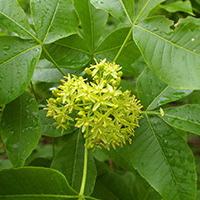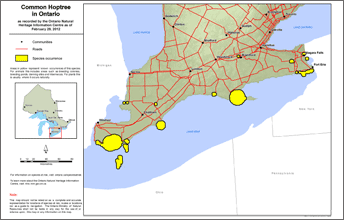Common hoptree (Species at Risk)
Scientific name: Ptelea trifoliata

Cover photo credit: Rob Tervo
Status
Special Concern
“Special concern” means that the species lives in the wild in Ontario, is not endangered or threatened, but may become threatened or endangered due to a combination of biological characteristics and identified threats.
Date added to the Species at Risk in Ontario List
The Common Hoptree was already assessed as threatened when the Endangered Species Act took effect in 2008. It was reassessed as a species of special concern in December 2016.
What it looks like
Common Hoptree is a small tree or a large shrub with smooth reddish-brown bark and alternate, three-parted compound leaves. Its cream-coloured, fragrant flowers bloom in early summer. The fruit, which is produced in late summer, is winged and contains one to three seeds.
Where it lives
In Canada, Common Hoptree is found often along shorelines in areas of nutrient poor sandy soils, although it is sometimes found on thin soils overlying limestone. It does best in full sun and is intolerant of shade.
Where it’s been found in Ontario
Common Hoptree ranges from the lower Great Lakes south to Texas, and from eastern Pennsylvania to northern Florida. In Canada, Common Hoptree is found only in southwestern Ontario along the Lake Erie and Lake St. Clair shorelines, on Lake Erie islands and near Lake Ontario in the Niagara Region.
View a larger version of this map (PDF)
What threatens it
In Ontario, the greatest threat to Common Hoptree is habitat loss and degradation due to development of the Lake Erie shoreline.
A twig-boring beetle has also caused significant damage to a few Common Hoptree populations in Ontario.
Action we are taking
Special concern species do not receive species or habitat protection, but may be eligible for grants to help with their protection and recovery.
Recovery strategy
A recovery strategy advises the ministry on ways to ensure healthy numbers of the species return to Ontario.
Read the executive summary (May 31, 2013)
Read the recovery strategy (May 31, 2013)
Government response statement
A government response statement outlines the actions the government intends to take or support to help recover the species.
Read the government response statement (March 14, 2014)
Review of progress
A review of progress made toward protecting and recovering a species is required no later than the time specified in the species’ government response statement, or not later than five years after the government response statement is published if no time is specified.
Read the report on progress towards the protection and recovery of 16 species at risk, including Common hoptree (Ptelea trifoliata) (2019).
Habitat protection
General Habitat Protection - June 30, 2013
What you can do
Report a Sighting
- The Ministry of Natural Resources and Forestry tracks species at risk such as the Common hoptree. You can use a handy online form to report your sightings to the Natural Heritage Information Centre. Photographs with specific locations or mapping coordinates are always helpful.
Report a sighting
- Report a sighting of an endangered animal or plant to the Natural Heritage Information Centre. Photographs with specific locations or mapping coordinates are always helpful.
Be a good steward
- Private land owners have a very important role to play in species recovery. If you find Common hoptree on your land, you may be eligible for stewardship programs that support the protection and recovery of species at risk and their habitats.
- Invasive species seriously threaten many of Ontario’s species at risk. To learn what you can do to help reduce the threat of invasive species, visit:
- Pollinators, such as bees, are in steep decline across the globe and they play a key role in the survival of many of Ontario’s rare plants. For information on how you can help scientists monitor pollinator populations in Ontario visit Seeds of Diversity
Report illegal activity
- Report any illegal activity related to plants and wildlife to
1-877-TIP-SMNR (847-7667) .
Quick facts
- Common Hoptrees are pollinated by a large variety of insects including bees, flies, and beetles. Common Hoptree is one of two native larval host plants for the rare Giant Swallowtail butterfly.
- Aboriginal people used the Common Hoptree for a variety of purposes including a cure for stomach aches. Poison made from Common Hoptree leaves was applied to the tips of arrows for hunting large game.
